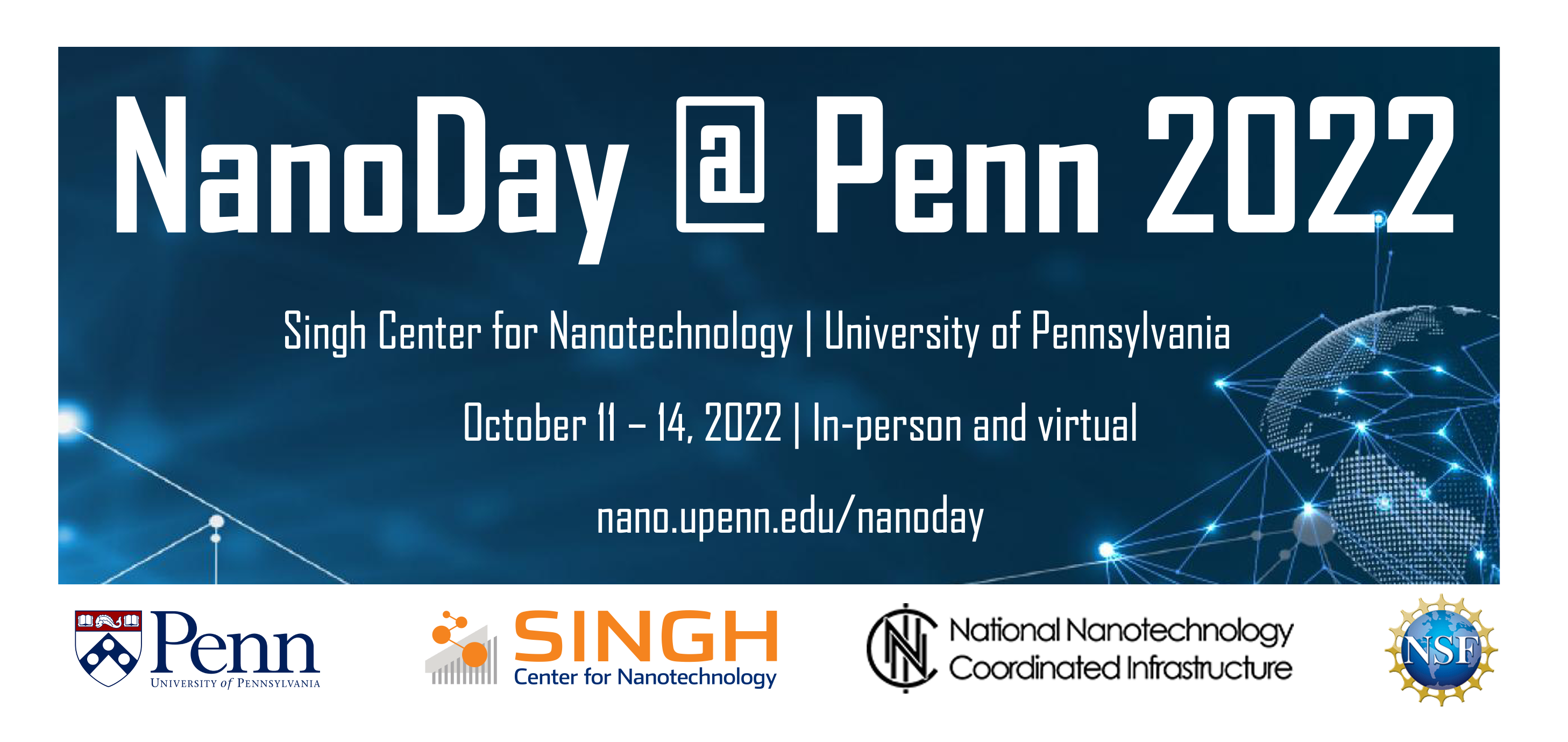NanoDay@Penn 2022
October 11-14, 2022,
Introduction
Nanotechnology is around us! Learn Nanotechnology, meet professionals and discuss careers associated with nanotechnology. The Singh Center for Nanotechnology at the University of Pennsylvania hosts high and middle school students at NanoDay @ Penn 2022. Meet researchers, engineers, entrepreneurs, undergraduate and graduate students at Penn, Drexel, Temple and Jefferson University. Sign up for in-person and/or online synchronous sessions for your classes and clubs.
Sign up: Registration is now closed. Registration Link
Contact: Dr. Gyuseok Kim (kimgyu@upenn.edu) for any questions regarding this event.
Instruction
Teachers are required to sign up for sessions for their classes or club.
Most in-person sessions are only for one class, team, or club. The schedule of in-person presentations can be slightly adjusted (5-10 min) depending on the classroom or club schedule upon the teacher’s request.
Presenters will choose the school for the presentation if multiple teachers sign up for an in-person session. The teacher who signed up first will be considered first. Presenters will visit the school.
Multiple teachers can sign up for online synchronous sessions.
Agenda
Presentations
- Sandwich Composite Materials and Paper Cups
- The presenter will provide multiple demos in the classes of a teacher, in-person
- Presented by Igor Bagatin lab (Penn)
- Related courses: Any middle school students
- Abstract: Have you ever wondered why cardboard can be so strong yet also very lightweight? The answer lies within its wavy, or corrugated, interior. In this Nano Week 2022 presentation we will explain what makes corrugated materials so great and explore their uses at scales both large (airplanes and cars) and small (nanostructures in our own research). Students will participate in several experiments to explore and discover the amazing properties of corrugated materials for themselves. We will also leave time to discuss highlights of our group’s nanoscale research and answer questions about careers in STEM fields. Presentation will be live in person (we will come to your school). Best suited for middle school math or science classes.
- Quantum Dots and QD-based Devices: Nanotechnology Enabled by Chemistry
- Oct 11th, 9:30 am, for 30-40 min, online synchronous
- Presented by Dr. Pat Watson (Penn)
- Related courses: Physics, Chemistry.
- Solar-powered Refrigeration
- Oct 11th, 10:30 am, for 30-40 min, in-person
- Oct 11th, 12 pm, for 30-40 min, in-person
- Oct 11th, 3 pm, for 60 min, in-person
- Presented by Dr. Sam Azadi and Dr. Jason Rohr (Penn)
- Related courses: Any STEM classes or clubs
- Abstract: Solar power is a renewable source of energy that can be used to power everyday appliances. We explain how solar power can be harvested to produce electricity. We subsequently show examples of solar cells fabricated at the Singh Center at the University of Pennsylvania, and use solar cells to power hand-held refrigeration devices.
- Introduction to Microscopy: How do we Surpass the Diffraction Limit?
- Oct 11th, 1 pm, for 30-40 min, online synchronous
- Presented by Prof. Kyle Wagner (Thomas Jefferson University)
- Related courses: high school chemistry, physics, or engineering courses
- Abstract: Nanoscience requires visualizing objects that our eyes cannot resolve, even with state-of-the-art technology, simply because our eyes rely on light. We are able to image objects much smaller than the wavelengths of visible light, but we need to implement different tools. This presentation will highlight the diffraction limit and the limitations of optical microscopy, and will also introduce some of the basic concepts of scanning electron microscopy and atomic force microscopy. Believe it or not, but microscopy can be a bit like a game of dodge ball. We will see how we can apply observations from dodge ball to display how some of these microscopy techniques operate.
- Chemistry and Energy
- Oct 11th, 3 pm, for 60 min, in-person
- Presented by Prof. Michael Zdilla (Temple University)
- Related courses: Any STEM clubs
- Abstract: Energy production, storage, and conversion is one of the biggest challenges facing humanity, and is intimately linked to chemistry and chemical technology. I will present an overview of what energy is, how it is stored now and converted now, and how scientists think about the problems associated with energy conversion and storage.
- Tribology: The Science of Slipping, Sticking and Sliding
- Oct 12th, 10 am, for 30 min, online synchronous
- Oct 12th, 3:30 pm, for 30 min, online synchronous
- Presented by Robert Carpick lab (Penn)
- Related courses: Physics class or clubs
- Abstract: Have you ever wondered how geckos can stick to walls, why your hands sweat when you’re nervous, or why your car will break down if you don’t change the oil? The field of “tribology” studies these scientific questions, all of which can be addressed using the physics of friction, adhesion, and lubrication. We’ll discuss the many places where tribology is part of everyday life, and then we’ll zoom in for more detail — figuratively and literally! Our laboratory specializes in tribological effects that are 100x smaller than the width of a human hair: atoms, monolayers, 2-D materials, and more. We’ll show how these miniscule events can inform scientific breakthroughs, contribute to green technologies, and satisfy our curiosity about geckos.
- 3D Printing at the Nanoscale
- Oct 12th, 11 am, for 30 min, online synchronous
- Presented by David Jones (Penn)
- Related courses: Engineering, chemistry, or physics
- Abstract: In this demonstration, you’ll be introduced to the basic principles of 3D printing structures at the nanoscale. In addition, you will see a demonstration of UPenn’s Nanoscribe tool, which will perform such a 3D printing.
- The Fascinating World of Two-Dimensional Carbides and Nitrides (MXenes)
- Oct 12th, 1 pm, for 30 min, in-person
- Presented by Yuri Gogotsi lab (Drexel University)
- Related courses: High school science class, physics or chemistry, or club
- Abstract: Two-dimensional flakes called MXenes, with alternating layers of transition metals and carbon/nitrogen, have jumped into the limelight due to their attractive properties and resulting practical applications. The family of MXenes has been expanding rapidly since the discovery of Ti3C2at Drexel University in 2011 and are the only major family of materials discovered in the 21st century. MXenes are the fastest growing family of inorganic materials and may well become the largest one with an almost infinite number of combinations of M-element metals (like titanium or molybdenum), X-elements (carbon or nitrogen) and surface terminations (oxygen, hydroxyl, etc.), and can be assembled in a variety of distinct structures. The versatile chemistry of MXenes renders their properties tunable for a variety of applications, such as enabling fast storage of electrical energy, leading us to batteries recharging much faster compared to the currently used ones. They can also be used in telecommunication (printable antennas), energy conversion (photovoltaics), water desalination, wearable and flexible electronics, cancer treatment, kidney dialysis, and many other applications.
- Nanotechnology for Neuroengineering and Rehabilitiation
- Oct 12th, 3:30 pm, for 60 min, online synchronous
- Oct 13th, 10:00 am, for 30-40 min, online synchronous
- Presented by Flavia Vitale lab (Penn)
- Related courses: Science, biology, physics or chemistry, anatomy classes, or clubs
- Abstract: Bioelectronic technology allows us to study and monitor disorders by interfacing electronic devices with living systems. In order to improve the capabilities of current bioelectronic tools, the Vitale Lab has developed novel electrode technology using MXene, a two-dimensional nano-material that is highly conductive and biocompatible, to enable recording biological signals at higher resolutions. We will demonstrate both micro and macro scale electrodes made of MXene for sensing a variety of biological signals and showcase the benefits of MXene for developing soft, flexible devices.
- How to See Nanoscale Things: Electron Microscopy
- Oct 13th, 10:00 am, for 30 min, online synchronous
- Presented by Dr. Jamie Ford (Penn)
- Related courses: Any STEM classes
- Abstract: Whereas we use visible light to see objects, we can use electrons to see nanoscale objects. I will demonstrate an electron microscope to see a small object and explain how this tool works.
- How to Study Cancer using Glow-in-the-dark Jellyfish and a Microscope
- Oct 13th, 3:00 pm, for 60 min, in-person
- Presented by Bojana Gligorijevic lab (Temple)
- Related courses: Science, biology, physics, technology clubs
- Abstract: Have you ever wondered why fireflies glow at night? This is the result of a phenomenon called fluorescence. Many marine animals such as jellyfish use fluorescence to glow in the dark. Since we can’t bring a jellyfish into the classroom to see an example of fluorescence with our own eyes, we display this phenomenon using a UV flashlight to see tonic water glowing under UV light. Further in the presentation, we will explain how scientists use fluorescence to study cancer. Using fluorescence, we can label different parts of the cell with different colors and record movies in real-time. At the Department of Bioengineering at Temple University, we use fluorescent proteins to investigate cells under microscope and visualize how cancer spreads. By the end of the presentation, you will understand better how fluorescence works, and how it can be used in the research laboratory.
- How Nanotechnology Flies Planes – A introduction to MEMS devices and NanoFabrication Sensors
- Oct 14th, 9:30 am, for 30 – 40 min, in-person
- Presented by Cynthia Sung lab (PENN)
- Related courses: Physics, Chemistry, Nanotechnology, Robotics, or Computer Science.
- Abstract: Micro-Electromechanical systems (MEMS) are microscale systems that range in size from a few micrometers to millimeters. This technology is used to manufacture different sensors such as Pressure or Temperature utilized by cars, aircrafts, drones, and more. This workshop aims to act as an educational introduction to MEMS devices and their uses through a hands-on lab using the MPU6050 Accelerometer and Gyroscopic sensor. Students connect the sensor to a paper airplane, an (Arduino) microcontroller, and a computer to construct a live graphical aircraft attitude indicator. This lab is an introduction to basic nanotechnology principles, applications of MEMS devices, data processing, and programming (C++/Processing).
- Nanomaterials for Energy Storage
- Oct 14th, 10:00 am, for 30 min, online synchronous
- Presented by Yuri Gogotsi lab (Drexel University)
- Related courses: Any physics, electronics, or math classes. Engineering, physics, or electronics clubs.
- Abstract: Energy storage is a booming field with the use of batteries in electric vehicles, consumer electronics, and grid power storage. With the energy demand growing, and the types of storage diversifying (high power vs. high energy), nanomaterials can be used to bridge gaps, fill niches, and expand on current energy storage technologies. This talk will cover the fundamentals of batteries and supercapacitors, and how nanomaterials are used in these systems.
- Career Development: Meet Penn Undergraduate and Master’s Students
- Oct 13th, 4:00 pm, for 60 min, online synchronous
- Presented by Thomas Mittelbrun, Victoria Fethke, Sharon Zheng, Eric Sigg, and Danielle Sclafani.
- Related courses: Any STEM classes or clubs.
- Abstract: Meet undergraduate and Master’s students at Penn. Panels will talk about their STEM journey and answer questions from middle/high school students. Online synchronous session.
- Career Development: PhD Student Panel – Discovering stem cells to coding to quantum
- Oct 14th, 11:00 am, for 40 min, online synchronous
- Presented by: Nima Leclerc, Noah Johnson, Anna Neuman, Joseph Lance Casila (Penn)
- Moderator: Kristin Field, Director of Education and Professional Development at the Singh Center for Nanotechnology
- Related courses: Any STEM classes or club
- Abstract: Different careers require different amounts of education. After a college undergraduate degree, some people go on to study in PhD programs to learn how to be experts in specific areas of science, technology, engineering and math (STEM). This type of graduate training allows students to focus on particular STEM topics of interest and to learn how to be expert researchers in something new to the world.
This session is appropriate for anyone interested in learning a little about how things are discovered in STEM and meeting students who will contribute to the future discoveries of our world.
- Career Development: Meet Entrepreneurs and Engineers
- Oct 14th, 4:00 pm, for 60 min, online synchronous
- Presented by Dr. Sagar Yadavali (Infini-fluidics), Dr. David Niedzwiecki (Goeppert) and Shaelynn Fisher (Avisi)
- Related courses: Any STEM classes or clubs
- Abstract: Meet entrepreneurs and engineers making nanotech devices at Penn. Panels will talk about their job and STEM journey and answer questions from middle/high school students. Online synchronous session.





